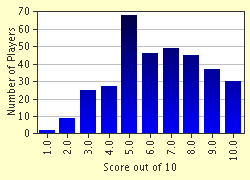Quiz Answer Key and Fun Facts
1. British Sign Language and American Sign Language are:
2. Fingerspelling (spelling out words letter by letter) is a useful skill, but is a poor substitute for a knowledge of sign language because:
3. In American Sign Language, fingerspelling requires the use of two hands.
4. Sign language can be defined as communication using only the hands.
5. Some in the Deaf community use a sign language as their first language. Some educators believe that it is very important to learn a spoken language. What is this belief called?
6. Sign languages are not 'simple' and can convey complex ideas as effectively as spoken languages.
7. British Sign Language has a sign for every common word in British English, and shares the same grammar.
8. Culturally Deaf people (those who feel a part of Deaf community) would generally love to be able to hear perfectly and communicate using spoken languages.
9. Sign languages would be a useful method of communication for deaf people who also:
10. Despite the plethora of different sign languages, an international sign language was developed. Like all 'invented' languages, it has proved unpopular. What was its name?
Source: Author
riotgrrl
This quiz was reviewed by FunTrivia editor
Beatka before going online.
Any errors found in FunTrivia content are routinely corrected through our feedback system.

